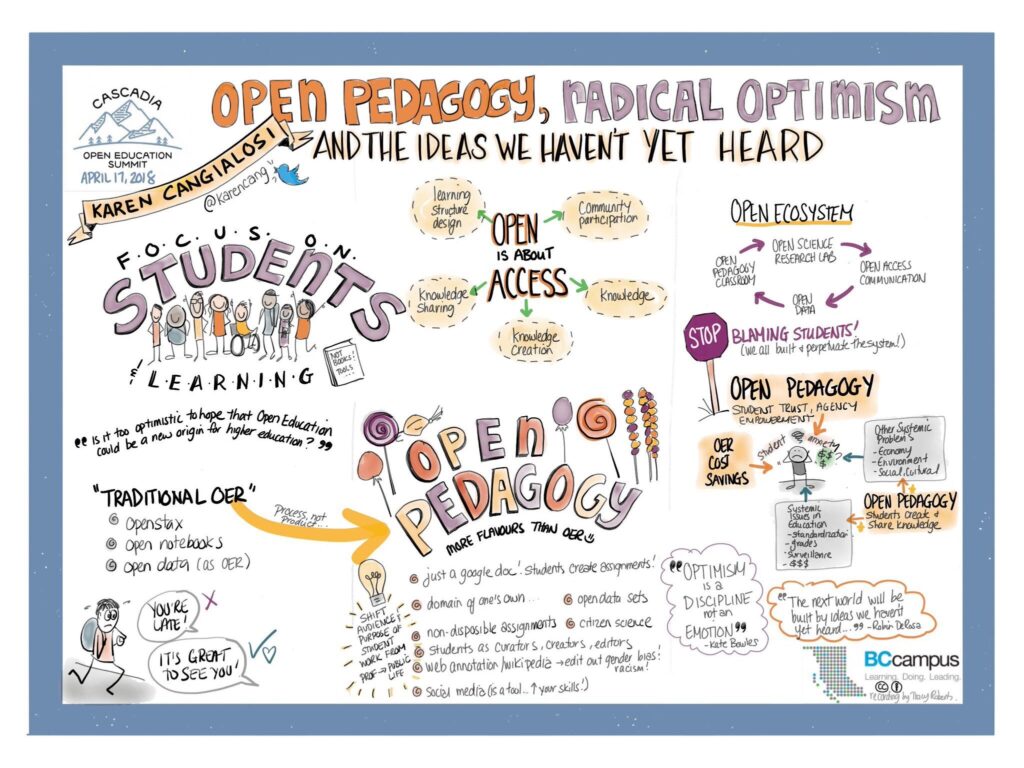
4 Beyond Access: Using Open Educational Practices (OEP) to Empower Students
Adapted from “DSCF4187” by okfn, which is licensed under CC BY 2.0
In the previous Learning Area 3, we focused on course materials and OER. In Learning Area 4, we focus on Open Educational Practices (OEP), teaching and learning practices intended to empower students. In what ways might you incorporate OEP into your institution’s Open Education strategic plan?
Key Takeaways
- Define Open Educational Practices (OEP), its characteristics, and value in teaching and learning.
- A clearer connection between OEP and Social Justice and between OEP and other DEI practices and initiatives
- A set of practices, strategies, and policies you can use to integrate Open Pedagogical Practices into your institution’s Open Education strategic plan.
JUNE 3-7: Asynchronous Activities
What are Open Educational Practices (OEP)?
4.1 Please watch this short 3-minute video by Catherine Cronin which explains what OEP are and how they can enhance the learning experience for our students.
How Can Open Pedagogical Approaches Support Inclusive Teaching Practice?
4.2 Please watch this talk by Jasmine Roberts-Crews. The video starts around the 28:17 mark. As you listen, think about the ways in which OER use and open pedagogical approaches can support culturally responsive and inclusive teaching practice.

Now that you have viewed the video and reflected on key points, it’s time to read and annotate.
4.3 First, here are the two articles to read AND annotate:
- View of Changing our (Dis)Course: A Distinctive Social Justice Aligned Definition of Open Education (Lambert, 2018). Lambert’s work was references in Roberts-Crews’ talk and is an important touchstone for this work.
- Framing Open Education from a Social Justice Perspective.(Bali, Cronin, & Jhangiani, 2020)
4.4 Next, here are some other important materials you can review on your own.
- SPARC OER Primer
- Open Pedagogy Notebook
- Student as Content Creators (section from RLOE Sustainability Guide)
- The United Nations Sustainable Development Goals Open Pedagogy Fellowship (see examples of Student Projects under Resources)
4.5 Finally, spend a little time reviewing the following Graphic Illustration below, which encapsulates many of the open pedagogical main ideas we are exploring together in this learning area.

4.6 Answer all of the questions below for yourself. Then go to OEG Connect Learning Area 4 and post about the one question there. **IMPORTANT NOTE: You must be logged into OEG Connect in order for the link to work and take you directly to the discussion thread.
- What were your takeaways from Roberts-Crews’ talk?
- How can open pedagogical practices help raise the voices of your underserved and marginalized students?
- What does it mean to give students more agency? How might empowering students make them more successful as learners?
- What examples of open practices or open pedagogy assignments did you find exciting?

4.7 It’s time to think about the resources needed for your open education strategic plan. Here we challenge you to think about both funding and other “outside the box” resources like opportunities to partner with external stakeholders in ways that benefit the community or the use of campus spaces or the alignment of your strategic plan with important initiatives currently underway on your campus.
- Please DRAFT III. Resources in your strategic plan.
- Please REVIEW at least three of your colleagues’ III. Resources section.
- Please PROVIDE FEEDBACK. This can be comments, reactions, questions, etc.
- You can do this by using the Insert>Comment feature in Google Docs or by typing directly into the document.
- Remember that all our strategic plans are accessible in the Strategic Plans RLOE Cohort 3 Folder.
- Use this asynchronous collaborative opportunity to learn from each other and to enhance your own strategic planning.
WED, JUNE 8: Synchronous Zoom Session

Week 2/Session 1 Zoom Session
WEDS, JUNE 8, 2-4:30 pm EASTERN
Find your time zone
Topics: OEP and Student Empowerment
